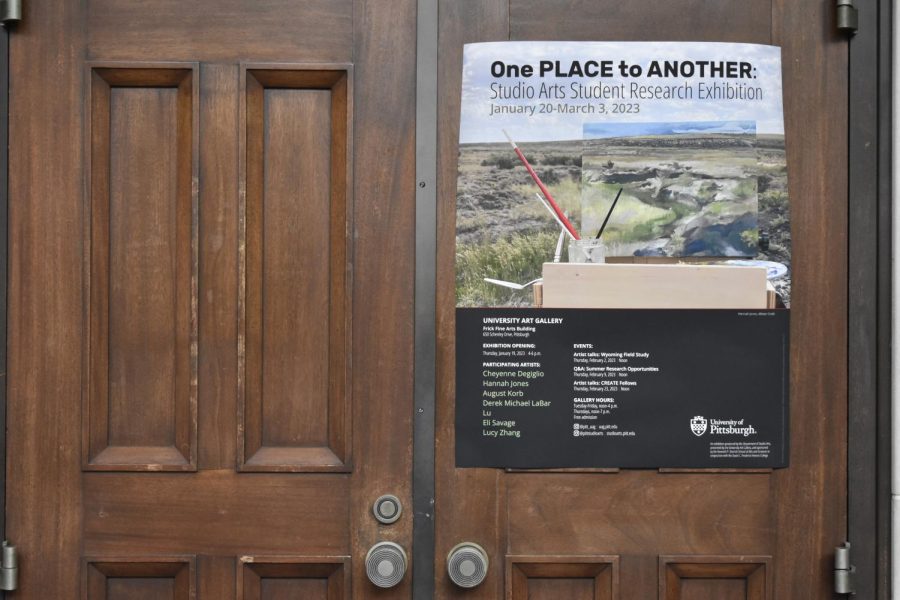‘One Place to Another’ art exhibit highlights students’ relationships with nature, wildlife
Romita Das | Senior Staff Photographer
A sign advertising the “One Place to Another” exhibit in the Frick Fine Arts building.
February 23, 2023
Hannah Jones, a senior studio arts major, contributed six photographs to the “One Place to Another” exhibit in the Frick Fine Arts Building. The photos capture Wyoming’s natural landscapes and wildlife, taken during her time in the Studio Arts’ field study program.
The University Art Gallery presents the exhibition, which is available through March 3. The exhibit includes the work of seven Pitt students who spent last summer participating in field studies in various locations. Students showcased their research experiences through photos, video, laser, sculpting and other art forms.
Jones created three different pieces to capture her experience in Wyoming 一 a collection of six photographs, a recreation of nest colonies and a painting of a prairie. She said in her artist statement that despite the rigorous conditions of the nature preserve where she resided, she enjoyed the connection she felt with her surroundings.
“It was about a 30-minute hike to my painting spot. The sun was harsh, and all my supplies were awkward to lug around, but it was worth it to soak in my environment,” Jones said. “The painting is what I focused on first in the moment of being in Wyoming. The photographs I also were making at the same time, but the nest was a reflective art after I had left Wyoming.”
Jones said she took inspiration from her surroundings, such as in her nest recreation project.
“The nest is made out of paper pulp mixed with glue and water, and pressed as molds which were based off of what the cliff swallows’ nests looked like,” Jones said. “I wanted to emphasize the form that they make, which is kind of uncanny but beautiful.”
Jones spent a significant part of her summer grinding the soil of the Wyoming prairie to use in her painting and to collect as samples. She said she found seven shades of soil which she used as components of her painting.
“Out west is very beautiful, there is so much exposed rock and soil which is very different from here,” Jones said.
She said in her artist statement that she is fascinated by the role that nests play in nature, which inspired her to pursue her nest recreation.
“The birds create these impressive structures by mixing mud with their own saliva,” Jones said. “I share these facts because they are remarkable and because they are a clear example of how nonhuman animals alter their landscapes.”
Jones’ experience in Wyoming was shared by other artists, including 2022 graduate Eli Savage. He produced his painting “Cognitive Restructuring” during his time in Wyoming. Savage painted with handmade stencils on raw, unstretched canvas. He drew from the concept of dialectical behavior therapy, he said in an artist statement.
“The steady routine of life in Wyoming, the instant, pleasantly sedating heat and the vast, calm landscape led me towards work that was time-consuming, repetitive and meditative,” Savage said.
Savage said his experience in Wyoming had an emotional impact on him.
“In Wyoming, the hectic news cycle of the summer of 2022, as well as personal issues boiling over out of sight on the other side of the continent, felt hazy and distant as long as I allowed them to,” Savage said. “I could not decide if my non-reaction to all of it was healing and therapeutic or lazy and avoidant.”
Cheyenne Degiglio, a senior psychology major and an Honors College creative arts fellow, was also featured in “One Place to Another.” Degiglio developed and workshopped a creative project of her own. She said in an artist statement that her work was inspired by her experience growing up in the Appalachian Mountain region.
Degiglio captured photos that share intrinsic details of a rural community experiencing abandonment.
“[I] researched a lot about the region [I] grew up in, and learned about ways that people in rural communities uniquely suffer from the disease of despair, and how that creates the rural mortality penalty, or the phenomena where people in rural communities die earlier than those in suburban or urban communities,” Degiglio said.
Jones said her trip to Wyoming allowed her to spend time outdoors and familiarize herself with wildlife, which is reflected in her photos.
“I love being outside, I think that’s the reason I wanted to go out [to Wyoming],” Jones said. “I love identifying animals — that is weirdly a big part of my art practice, identifying things — which has a certain rigidity with it, but I like the way that it’s a way of keying into observation, and it’s almost meditative for me.”



